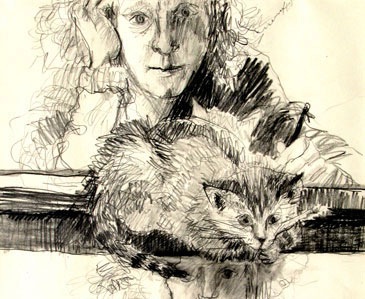
The beginning of a painting is the most interesting time: I like to have the paint wet and alive, so I use oil paint on gessoed hardboard with oil of clove added to the painting medium to retard drying. The painted board goes into a box inside a plastic bag: the paint stays wet and changeable for weeks. I remove the paint with stiff cardboard, rags, or Qtips before changing a color rather than painting wet paint over dry paint. This makes the paint more luminous with the white gesso illuminating the paint, much like white paper illuminates watercolor. I can "draw through" the paint with pieces of mat board or wooden sticks to expose the white gesso as stark lines, giving the painting the graphic quality of a drawing.
The garden oil paintings are painted directly on-site in my backyard. I have designed my home garden for painting purposes rather than traditional garden aesthetics. From several shady vantage points I have flowers lined up from background to foreground to form pleasing compositions.
In the monotype printmaking method I paint on bevelled plexiglass plates, then print the image onto damp paper with an etching press. This selection of monotypes contains images made with watercolors and with oil paints to which oil of clove has been added. The oil monotypes must be completed in a couple of days before the paint dries, while the watercolor monotypes can be worked on for weeks. The dried watercolor comes off the plexiglass plate because of the moisture in the damp paper. Recently I have experimented with printing one image from 3 watercolor plates. Painting on plexiglass allows for a lot of paint movement and change .... I can “draw through” the paint with wooden sticks ...it encourages strong graphics. It’s a fusion of my interest in printmaking and oil painting.
Digital images are printed on 90 lb. Arches hot press watercolor paper with an inkjet printer. Editions number 50 or less.

